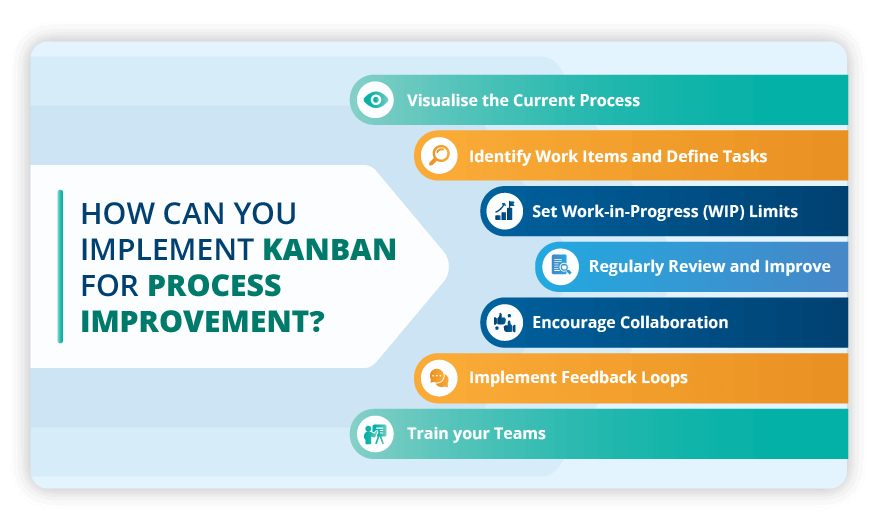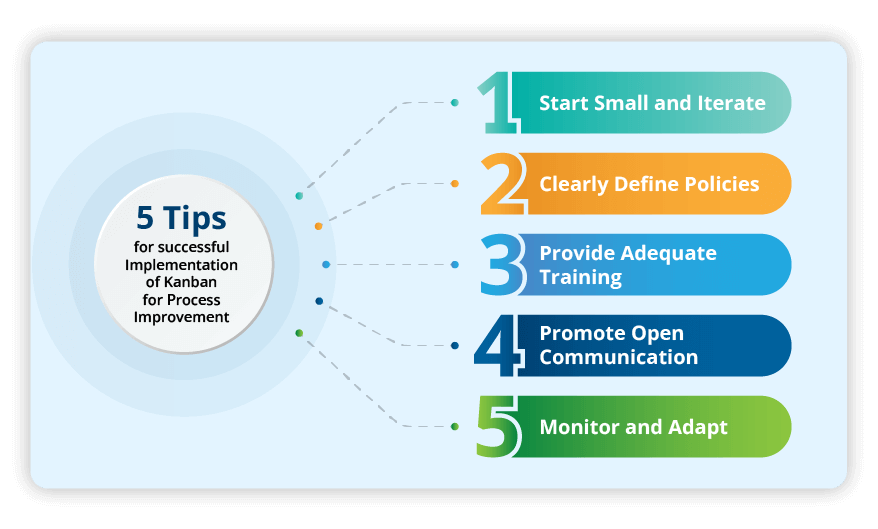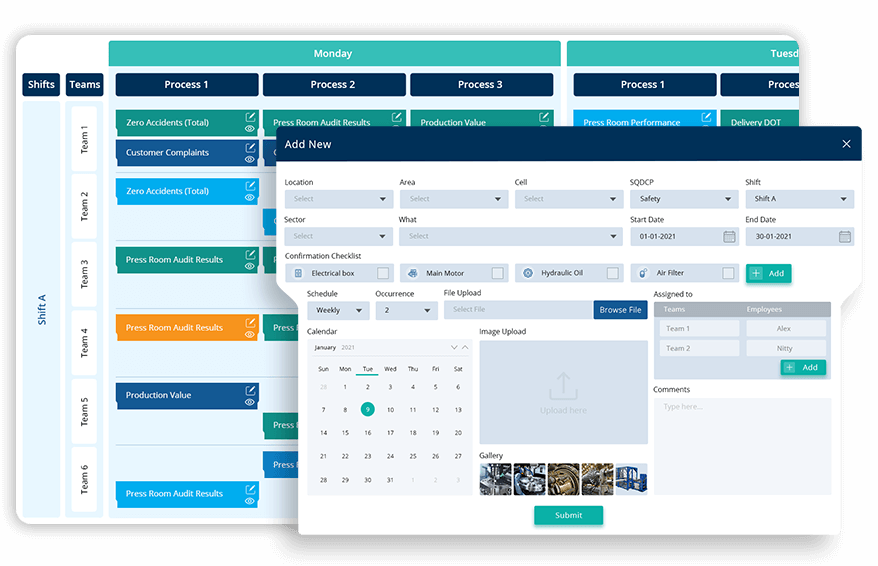A Comprehensive Guide to Kanban for Process Improvement
Kanban boosts continuous improvement through real-time visualisation, team collaboration, and addressing bottlenecks.
Start Kanban Free Trial Get a DemoContents
- What is Process Improvement?
- Kanban and Process Optimisation
- Why is Process Optimisation considered important in organisations?
- What are the Benefits of using Kanban for Process Improvement?
- How does Kanban help in visualising workflow and identifying bottlenecks?
- How do you manage WIP limits in Kanban for Business Process Improvements effectively?
- How does Kanban address the balance between Demand and Capacity in a given process?
- How can implementing Kanban enhance the processes in Project Management?
- How can you implement Kanban for Process Improvement?
- How does Kanban support the concept of Continuous Delivery and Deployment in Process Improvement?
- Business Process Improvement with Kanban- Common Challenges with their Solutions
- Example of Kanban in Process Improvement
- Can Kanban be applied to all types of processes across different industries?
- Which Metrics should be tracked to measure the success of a Kanban implementation?
- 5 Tips for successful Implementation of Kanban for Process Improvement
- How does Kanban handle unplanned work or emergencies within a project?
What is Process Improvement?
Process improvement is the systematic effort to enhance the efficiency, effectiveness, and quality of organisational processes. It involves identifying, analysing, and optimising workflows to achieve better outcomes and meet customer or stakeholder expectations. Lean process improvement, a widely adopted methodology, focuses on eliminating waste, increasing value, and promoting continuous improvement. Lean process improvement techniques include:
- Kaizen: Kaizen focuses on continuous, incremental improvements in processes, fostering a culture of continuous improvement.
- 5S (Sort, Set in order, Shine, Standardise, Sustain): 5S can organise the workplace for efficiency and effectiveness, reducing waste and enhancing productivity.
- Kanban: Kanban is a visual system that manages workflow, ensuring tasks are only pulled through the process when needed, reducing overproduction and waste.
- Value Stream Mapping (VSM): VSM can analyse and optimise the flow of materials and information for a product or service. It can also identify improvement areas.
- Just-In-Time (JIT): Just-In-Time is a manufacturing process improvement strategy that minimises excess inventory, reduces costs, and enhances operational efficiency by producing and delivering goods precisely when needed.
- PDCA Cycle (Plan-Do-Check-Act): The PDCA cycle provides a systematic framework for continuous improvement, ensuring ongoing monitoring and adjustment of industrial processes.
- Gemba Walk: Gemba walk involves leaders going to the actual workplace to observe processes, identify issues, and gain firsthand knowledge for process improvement.
- 5 Whys: Asking "why" repeatedly to get to the root cause of a problem facilitates a deeper understanding and effective problem resolution within a particular process that needs to be improved.
- Poka-Yoke: Poka-Yoke involves mistake-proofing mechanisms to prevent errors or defects in processes.
- Fishbone Diagram (Ishikawa or Cause-and-Effect Diagram): The Fishbone Diagram illustrates potential causes of a problem to identify root causes and find solutions collaboratively.
Kanban and Process Optimisation
Kanban is a visual management method that originated from Lean manufacturing and has found widespread application in various industries. It uses visual Kanban boards and Kanban cards to represent tasks or work items, allowing teams to monitor and manage workflow in real-time.
The Key Principles of Kanban include:
- Visualising workflow
- Limiting Work in Progress (WIP)
- Focus and flow
- Continuous improvement
By providing a clear and transparent view of the entire process, Kanban enables teams to identify bottlenecks, manage work efficiently, and optimise the flow of tasks. It contributes to process optimisation by reducing overproduction, minimising lead times, enhancing team communication, and promoting continuous improvement. This visual approach empowers teams to adapt to changing priorities, allocate resources effectively, and deliver high-quality results more streamlined and responsively.
Why is Process Optimisation considered important in organisations?
Business process optimisation is crucial in organisations because it increases efficiency, reduces costs, and enhances overall performance. By systematically refining workflows, organisations can eliminate bottlenecks, minimise waste, and improve the quality of products or services. Efficient processes improve delivery times, customer satisfaction, and competitiveness. Notably, Kanban is an indispensable tool in business process optimisation within shop floors, providing a visual framework that aids in identifying and addressing inefficiencies, optimising resource allocation, and fostering continuous improvement. Its adaptability and real-time visibility make it essential in pursuing streamlined and responsive operations, ensuring that organisations can meet evolving demands effectively.
What are the Benefits of using Kanban for Process Improvement?
- Visual Workflow Management: Kanban visually represents work items, allowing teams to see the entire workflow at a glance. This visual clarity enhances understanding and promotes effective communication within the team.
- Work-in-Progress (WIP) Limits: Kanban helps control the Work in Progress (WIP) at any given time, preventing overloading and allowing teams to focus on completing tasks before taking on new ones. WIP limits enhance efficiency and reduce multitasking.
- Continuous Improvement: Encourage continuous improvement by seeking feedback, identifying areas for enhancement, and making iterative changes to the Kanban process.
- Flexibility and Adaptability: Kanban allows teams to adapt to changing priorities and requirements quickly and efficiently, which is crucial in dynamic environments where prompt response to shifts in customer needs or market conditions is necessary.
- Task Prioritisation: Teams using Kanban can easily prioritise tasks based on urgency or importance. This ensures that critical work is addressed first, contributing to better time management and improved overall productivity.
- Reduced Lead Times: By visualising and optimising the workflow, Kanban helps minimise delays and reduces lead times for task completion. This results in faster delivery of products or services, enhancing customer satisfaction.
- Enhanced Collaboration: Kanban provides a visual platform for team collaboration. It fosters coordination and improves transparency.
- Increased Efficiency: By eliminating bottlenecks and establishing clear processes, Kanban contributes to increased workflow efficiency. This results in faster task completion and more streamlined operations.
- Customer Satisfaction: Kanban's ability to prioritise tasks and reduce lead times directly translates to improved customer satisfaction. Timely delivery of high-quality products or services is key to effective Kanban implementation.
How does Kanban help in visualising workflow and identifying bottlenecks?
Digital Kanban aids in visualising workflow by utilising Kanban boards and Kanban cards to represent tasks, creating a clear and transparent overview of the entire process. Each stage of the workflow is visually represented, allowing team members to see the status of tasks in real-time. This visual clarity facilitates easy identification of bottlenecks, as areas with high Work-in-Progress or where tasks tend to accumulate become immediately apparent. With this visual representation, teams can swiftly pinpoint bottlenecks, address workflow constraints, and optimise processes for smoother task progression. Kanban's continuous visibility enables teams to make data-driven decisions, enhancing overall workflow efficiency.
How do you manage WIP limits in Kanban for Business Process Improvements effectively?
- Set Clear WIP Limits: Define explicit limits for each workflow stage, specifying the maximum number of tasks allowed in progress simultaneously.
- Align WIP Limits with Capacity: Ensure that WIP limits align with the team's capacity, preventing overloading and maintaining a balanced workflow, which is crucial for business process optimisation.
- Regularly Review and Adjust: Periodically review and adjust WIP limits based on team performance, external factors, or changes in priorities related to process improvements.
- Enforce WIP Limits Strictly: Encourage strict adherence to WIP limits to prevent bottlenecks and maintain a consistent workflow, contributing to overall process efficiency.
- Visualise WIP Status: Use Kanban boards to visually represent the status of tasks and WIP limits for each stage, facilitating easy progress tracking and identifying potential business process improvement opportunities.
- Hold Regular Team Meetings: Conduct frequent team meetings to discuss WIP status, address challenges in the business process improvement journey, and collaboratively decide on necessary adjustments to WIP limits.
- Monitor Cycle Time: Track and analyse task cycle times to observe the duration it takes to move through the entire workflow, providing valuable data for refining WIP limits and enhancing overall business process efficiency.
How does Kanban address the balance between Demand and Capacity in a given process?
Kanban strategically addresses the balance between demand and capacity in a business process improvement by incorporating clear Work-in-Progress (WIP) limits. These limits function as a dynamic tool to harmonise the volume of work in progress with the team's capacity. By visualising tasks on a Kanban board and establishing explicit WIP limits for each workflow stage, teams can avoid overload scenarios and ensure an equilibrium in work distribution. When operations are carried out on a pull basis, new tasks are introduced into the workflow only when there is available capacity, preventing bottlenecks and maintaining a smooth flow. This Kanban-driven approach establishes a responsive and adaptive system that synchronises demand with the team's capability to deliver, resulting in heightened efficiency and consistently achieving high-quality outcomes in business process improvement efforts.
How can implementing Kanban enhance the processes in Project Management?
Implementing Kanban can significantly enhance processes in project management, with a particular focus on continuous process optimisation. The visual framework provided by Kanban promotes transparency and efficiency, contributing to streamlined project management processes. By utilising Kanban boards, teams gain a clear and visual representation of task statuses, enabling effective tracking, identifying bottlenecks, and prioritising work. Integrating Work-in-Progress (WIP) limits within Kanban ensures a balanced workflow, preventing overloading and supporting continuous process improvement initiatives. The pull system inherent in Kanban enhances adaptability to changing project priorities, facilitating optimised resource allocation in line with process improvement strategies. Regular reviews of performance metrics enable data-driven decision-making, ensuring that process improvement efforts are informed and effective. Emphasising continuous improvement, Kanban fosters a culture of innovation and efficiency within project management processes, contributing to ongoing process improvement success.
How can you implement Kanban for Process Improvement?

- Visualise the Current Process: Create a visual representation of the current workflow using a Kanban board to map each process stage. This provides clarity and transparency.
- Identify Work Items and Define Tasks: Break down the process into specific work items or tasks. Each task should be clearly defined, manageable, and represent a distinct unit of work.
- Set Work-in-Progress (WIP) Limits: Establish WIP limits for each process stage. These limits prevent overloading, encourage focus, and ensure a balanced workflow.
- Regularly Review and Improve: Conduct regular team meetings to review the Kanban board, discuss progress, and identify areas for improvement. Adjust WIP limits or processes based on feedback and performance metrics.
- Encourage Collaboration: Foster collaboration among team members by maintaining Kanban as the shared platform. This promotes communication, knowledge sharing, and a collective understanding of project goals.
- Implement Feedback Loops: Integrating feedback loops into the process to continuously gather insights. This can involve customer feedback, team retrospectives, or performance metrics to drive ongoing improvements.
- Train your Teams: Ensure team members understand Kanban principles and practices. Training sessions help establish a common understanding and commitment to the methodology.
How does Kanban support the concept of Continuous Delivery and Deployment in Process Improvement?
Kanban supports continuous delivery and deployment in process improvement by providing a visual and flexible framework. The visual representation of tasks on a Kanban board allows teams to monitor the entire workflow, identify bottlenecks, and optimise processes for efficiency. Work-in-Progress (WIP) limits and the pull system promote a balanced and controlled pace of work, preventing overloading and ensuring that tasks move seamlessly through each stage. This adaptability aligns with continuous delivery and deployment principles, allowing teams to respond promptly to changing priorities and consistently deliver high-quality results. The focus on regular reviews and continuous improvement in Kanban ensures that the process evolves with continuous delivery principles, supporting a dynamic and responsive approach to project management.
Business Process Improvement with Kanban- Common Challenges with their Solutions
- Resistance to Change: Implement a comprehensive change management strategy involving clear communication, training sessions, and highlighting the benefits of Kanban to gain buy-in from team members.
- Inconsistent Implementation: Establish standardised procedures for Kanban implementation across teams, ensuring a consistent and cohesive approach to business process optimisation.
- WIP Limit Challenges: Review and adjust WIP limits periodically based on team feedback and performance metrics. Encourage teams to collaborate on setting realistic and effective limits.
- Lack of Metrics and Measurement: Define Key Performance Indicators (KPIs) relevant to the organisation's goals. Regularly collect and analyse data to measure the impact of Kanban on process improvement.
- Limited Understanding of Pull System: Conduct training sessions to educate teams on the principles of the pull system. Emphasise the importance of only pulling in work when there is available capacity.
- Insufficient Training: Invest in comprehensive training programs to ensure that team members and leaders understand Kanban principles and practices.
- Failure to Foster Collaboration: Encourage a culture of collaboration by fostering open communication, creating shared goals, and emphasising the importance of collective success.
Example of Kanban in Process Improvement
Consider the example of a semiconductor manufacturing company facing challenges in inventory management, with frequent stockouts, overstock situations, and inefficient material flow. The goal is to optimise inventory processes, reduce lead times, and improve overall efficiency.
In this situation, Kanban implementation enhances the processes within the semiconductor manufacturing industry.
- Visualising Workflow: Set up a Kanban board with columns representing stages of the semiconductor manufacturing process, including wafer fabrication, photolithography, etching, deposition, and testing.
- Defining Work Items: Each work item on the Kanban board represents a specific semiconductor product, with details such as wafer size, design specifications, production quantity, and supplier information.
- WIP Limits: Implement Work-in-Progress (WIP) limits for each semiconductor manufacturing stage to prevent overproduction and ensure a balanced flow. For example, limit the wafers waiting for photolithography or the number of semiconductors undergoing testing simultaneously to maintain process efficiency.
- Prioritisation: Utilise colour-coded cards or tags to prioritise semiconductor production based on factors such as design complexity, customer demand, or project criticality.
- Regular Reviews: Conduct regular reviews of the Kanban board in team meetings to identify bottlenecks, discuss lead times, and address any issues affecting the flow of materials throughout the semiconductor manufacturing process.
- Metrics and Measurement: Define key metrics such as wafer yield, cycle time for each manufacturing stage, and inventory turnover of finished semiconductors. Regularly measure and analyse these metrics to assess the effectiveness of the Kanban system in optimising semiconductor manufacturing processes.
- Continuous Improvement: Encourage continuous improvement in semiconductor manufacturing by seeking feedback from the team, identifying areas for enhancement in wafer fabrication or testing processes, and making iterative changes to the Kanban system to improve semiconductor manufacturing efficiency over time.
Can Kanban be applied to all types of processes across different industries?
Yes, Kanban is a versatile methodology that can be applied to various types of processes across different industries. Originally developed in Manufacturing, Kanban has found widespread adoption in sectors beyond its origins. Its adaptability and simplicity make it suitable for knowledge work, services, and various business processes. Kanban's core principles, including visualising work, limiting work in progress, and enhancing flow, can be tailored to suit the unique characteristics of different industries. Whether in Automotive, Software development, Construction, Healthcare, Pharma, Plant Hire, Hospitality, Oil and Gas, HVAC or other fields, Kanban's effectiveness lies in its ability to provide transparency, promote flexibility, and foster continuous improvement in diverse processes. However, it's important to customise the implementation of Kanban to fit the specific needs and dynamics of each industry or process.
Schedule a Personalised Demo to understand how Kanban board can streamline Process Improvements in your Organisation
Which Metrics should be tracked to measure the success of a Kanban implementation?
- Lead Time: Measure a task or work item's time to move from the initial request to completion. A reduction in lead time signifies improved efficiency.
- Cycle Time: Track the time taken for a task to move through the various stages of the workflow. This metric provides insights into the actual time spent on active work.
- WIP (Work-in-Progress): Monitor the number of tasks currently in progress. This helps ensure that WIP limits are adhered to, preventing overloading and maintaining a balanced workflow.
- Throughput: Calculate the number of tasks completed within a specific time frame. Throughput reflects the team's capacity for delivering work efficiently.
- Blocked Time: Identify the amount of time tasks spend in a blocked state, indicating issues or bottlenecks in the workflow that need attention.
- Customer Satisfaction: Gather feedback from customers or stakeholders to measure their satisfaction with the timeliness and quality of deliverables.
- Waste Reduction: Assess the reduction in unnecessary work, delays, or rework. Kanban aims to minimise waste in the process, contributing to overall efficiency.
5 Tips for successful Implementation of Kanban for Process Improvement

- Start Small and Iterate: Begin with a limited scope and gradually expand, allowing for iterative adjustments and improvements in the process.
- Clearly Define Policies: Establish clear and concise policies to guide the use of Kanban, ensuring consistent understanding and adherence to the process.
- Provide Adequate Training: Offer comprehensive training to team members to ensure a solid understanding of Kanban principles and practices for effective process improvement.
- Promote Open Communication: Foster open communication for team members to discuss challenges, share insights, and collaborate for process improvement.
- Monitor and Adapt: Regularly monitor the Kanban system's performance, gather feedback, and be ready to adapt the process based on evolving needs and insights, ensuring ongoing success in process improvement.
How does Kanban handle unplanned work or emergencies within a project?
Kanban board can address unplanned work or emergencies within a project while contributing to continuous process improvement. The Kanban system incorporates flexibility by allocating a portion of the team's capacity for handling unexpected tasks. When unplanned work arises, it can be introduced into the system without disrupting the workflow. The visual nature of Kanban boards allows for real-time visibility into the status of all tasks, including unplanned work, enabling teams to prioritise and allocate resources effectively. This adaptability helps manage emergencies and provides valuable insights for process improvement. By regularly reviewing how unplanned work is handled and optimising response mechanisms, teams can enhance their overall process and be better prepared for future contingencies, contributing to continuous process improvement within the project.
Start Optimising your Process Improvements with Kanban Today!
Start implementing Kanban in your workflow today and experience better task management, smoother communication, and continuous improvement. Whether you’re new to Kanban or looking to refine your current processes, now is the perfect time to take action!


